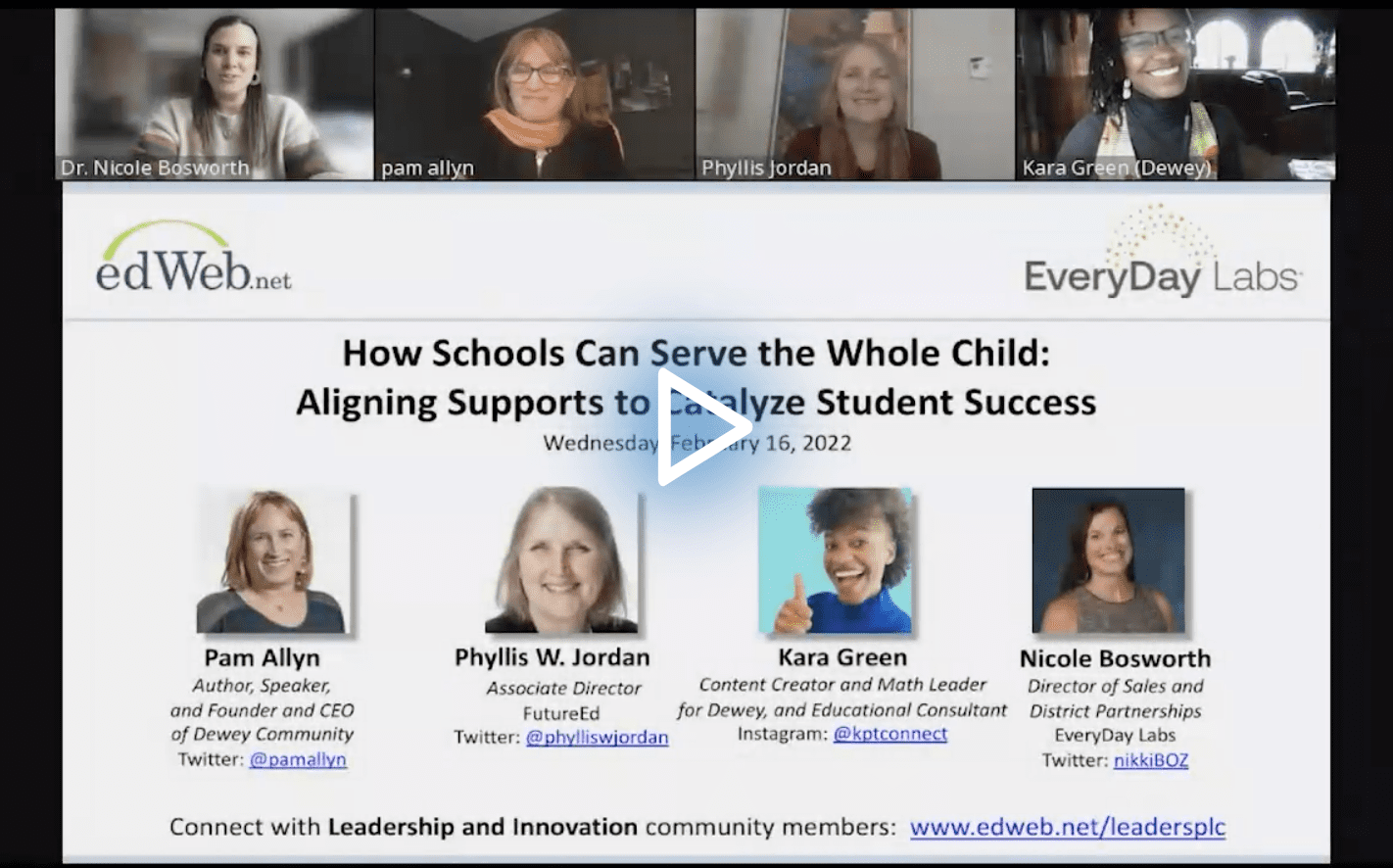A Renewed Look at the Whole Child with Families at the Core
Blog post by Michele Israel based on this edLeader Panel
COVID-19 hit schools and their communities hard. It heightened unfinished learning, disengagement, and absenteeism, all on a long list of conditions that require realignment. However, the pandemic also illuminated the benefits of a whole-child approach to teaching and learning that nurtures academic engagement and accomplishment.
In the edLeader Panel, “How Schools Can Serve the Whole Child: Aligning Supports to Catalyze Student Success,” educational experts recommended building on the enhanced whole-child strategy to meld further attendance, academics, social-emotional learning and family engagement to support student success in school.
The Whole Child, Post-Pandemic
The whole child concept has changed over the last two years, closing the distance between school and home and bringing to light what children and families do to support student achievement in school.
“Our children were really the only ones that were traversing that territory,” explained Nicole Bosworth, Director of Sales and District Partnerships at EveryDay Labs. “What’s happened over the last two years is that those lines have changed. People were able to open the windows to see into each other’s lives. It gives us a ream of hope to tell a new story of what education means.”
That story, said Bosworth, centers on students’ stories and visions about what school can be to bolster their learning in more imaginative ways. And it also calls for family voices to help define the rebuilding of education post-pandemic.
Moreover, a newer version of education invites educators to move from a deficit-based to a strengths-based view of learning. Instead of seeing students as struggling with a “learning gap” or “falling back,” teachers can appreciate that learners are pushing through a challenge, relying on strength and resilience to overcome learning obstacles, which they demonstrated throughout the pandemic.
The “New” Education Story: What’s Involved
According to the panelists, realigning education post-pandemic rests in several critical areas. Approaching them through a whole-child framework can expedite improvement.
Family Engagement and Empowerment
Crucial to student achievement is a family’s active role in their education, as discovered when their children learned at home during the pandemic. Then, teachers, students, and parents were educational partners. Post-COVID, this partnership should remain and grow stronger. Schools must provide spaces and resources that encourage parents to work with educators to:
- Model the value of socio-emotional health for their children to prepare them to learn. Learners should recognize that they’re humans who are open to growth, need help at times, must take breaks, and have the language to ask for support.
- Keep open the lines of communication with the school to be on the same page with educators about their children. Likewise, parents must not be afraid to stay in touch with the school to discuss and support their child’s learning experiences. Schools must make spaces, resources, and services available to families to empower them to boost their capacity for and confidence in constructively supporting their children.
- Be brave: Use the tools, resources, and school partners to support their children in learning, even if they don’t fully understand, let’s say, new ways of doing math or why it’s vital to read to their children. Families can draw on what they already know and the support provided to help their children solve problems and find solutions as they themselves are learning new strategies and concepts.
Attendance and Absenteeism
Families can have a significant impact on their children’s regular school attendance. Chronic absenteeism is at critical levels in schools around the country. EveryDay Labs data show alarming trends: students who need school the most (often the most vulnerable) miss in-person and online school; absenteeism rates among young children are growing; and with Omicron and quarantines, parent and student anxiety raised absenteeism rates.
Missing a lot of school has a negative impact: High school students may not graduate. Younger students tend not to develop the social skills they need to persevere, a sense of curiosity, or an awareness of engagement at school. They often read below grade level and lack necessary math skills.
What can schools and families do to ensure that children don’t miss the learning steps they need to head up the ramp to success and achievement? Looking at the whole child is critical to supporting students to address what they need. Here are a few steps educators and parents can take to reduce absenteeism:
- Educators must be sensitive to what keeps students away from school and use empathy to make it easier for families to get their children to school. For example, invite questions such as, “What is stopping you from sending your child to school? What feels hard about that? What seems to be getting in your way?”
- Parents, teachers, and students can come together to figure out what will bring children to school. What programs would work and appeal to a range of ages and grades? What could they put in place that gives learners the tools they need to be successful? What supports can students have access to when they need help? How can learning and instruction be more creative and joyful while building communication skills and problem solving? How can schools reinvent and reimagine education to capture what children love? And, most crucial, what will allow students to be with their peers and make friends, critical not only to academic support but socio-emotional well-being?
- Parents must believe school attendance is essential. They must be sure that schools are safe, they can trust the teachers and feel connected to the school themselves to encourage their children to attend school regularly.
- Families need to know how many days of school their children have missed. Unfortunately, they often don’t know—they may think it’s five days when it’s closer to 20! Family engagement helps here: When parents help students with their homework, for example, they know what they are learning and support their achievement, practices that boost attendance.
Social-Emotional Health
Finally, bringing social-emotional health to the forefront of learning is crucial to student achievement. To nurture a robust school-family partnership and propel student success, schools should:
- Create a sense of belonging for families, honoring language, culture, and the family itself, the strongest muscle of a child.
- Establish and maintain a strengths-based ecosystem that more holistically addresses problems, such as bullying.
- Use funds to strengthen socio-emotional programming: Purchase curricula, training, or materials, hire psychologists, launch restorative practices, and provide telehealth offerings.
- Listen deeply to families and children about ways to create empowering learning environments.
- And finally, drive students’ abilities to change their narratives and improve their abilities to do something, like read a long book or do math, because they believe they can.
Learn more about this edWeb broadcast, “How Schools Can Serve the Whole Child: Aligning Supports to Catalyze Student Success,” sponsored by EveryDay Labs.
Watch the Recording Listen to the Podcast
Join the Community
Leadership and Innovation is a free professional learning community that serves as an online forum for collaboration on leadership and innovation in schools to meet the needs of the next generation.






Comments are closed.